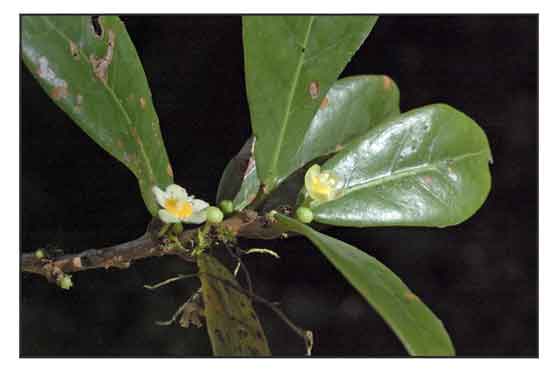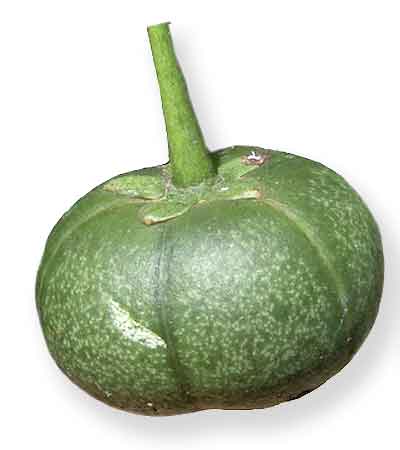 Gen info Gen info
- Actephila is a genus of about 36 species of flowering plants in the family Phyllanthaceae native to Southeast Asia, China, the Himalayas, Papuasia and norther Australia. Plants in the genus as monoecious trees or shrubs with entire leaves usually arranged alternately along the branches, and flowers arranged singly or in clusters in leaf axils, usually with 5 sepals and petals. (9)
- The genus Actephila was first formally described in 1826 by Carl Ludwig Blume in his Bijdragen tot de Flora van Nederlandsch Indie.
- Etymology: The genus name Actephila derives from two Greek words, akte, "the seashore", and philos, "loving", referring to a coastal habit.
Botany
• Small trees. Young stem, bracts and calyx lobes hispid without. Leaves 7-20 x 2-5 cm, lanceolate to oblanceolate, acute at apex, attenuate at base; petioles 0.5-1 cm long. Flowers axillary, clustered; male many, short-pedicelled; female 1-2, long-pedicelled. Male flowers: Pedicels 0.3-0.4 cm long. Calyx lobes 5, hairy without. Petals 5, smaller than calyx, white; disc lobed. Stamens 3-6, attached on the disc, filaments united to form a gonophore; pistillode present within gonophore. Female flowers: Pedicel 1-1.3 cm long. Ovary ovoid, 0.4-0.5 cm long, 0.3-0.4 cm diam, 3-celled; ovules 2 in each cell; styles 3, each again 2-fid to form 6-stigmatic lobes, lobes papillate. (India Biodiversity Portal) (5)
 • Trees, shrubs or subshrubs, perennial, monoecious, evergreen; stems and foliage without latex. Indumentum of simple or glandular trichomes; scales and stinging trichomes absent. Stipules entire, generally inconspicuous, deciduous. Leaves alternate, subverticillate or subopposite, ± sessile to petiolate, simple and elobate, flat to plicate to recurved or revolute, entire or toothed, coriaceous or chartaceous, penniveined; glands absent. Inflorescences fasciculate or solitary, axillary, extra-axillary, rarely interpetiolar, or on short brachyblasts, uni- or bisexual, with flowers in bracteate groups. Male flowers pedicellate; calyx lobes 4–6, imbricate, ± equal; petals 2–6, often scale-like or absent; disc extra-staminal, annular, 4- or 5-lobed (rarely 6), or entire and rounded; stamens 3–6, inserted on the disc; filaments free, filiform; anthers introrse, bilobate; thecae oblong and longitudinally dehiscent; pistillode trifid. Female flowers pedicellate; calyx lobes 4–6, imbricate; petals 2–6, often scale-like or absent; disc annular, cupular or lobed, fleshy; ovary 3-locular, with locules biovulate; styles free or shortly connate at base, entire or bifid. Fruit capsular, rounded, 3–5-lobate, with surface bullate, glabrous or pubescent, dehiscing loculicidally and partly septicidally into bivalved cocci; columella persistent. Seeds deltoid; testa crustaceous; albumen absent; caruncles absent or present; cotyledons thick, sometimes plicate. (Flora of Australia) • Trees, shrubs or subshrubs, perennial, monoecious, evergreen; stems and foliage without latex. Indumentum of simple or glandular trichomes; scales and stinging trichomes absent. Stipules entire, generally inconspicuous, deciduous. Leaves alternate, subverticillate or subopposite, ± sessile to petiolate, simple and elobate, flat to plicate to recurved or revolute, entire or toothed, coriaceous or chartaceous, penniveined; glands absent. Inflorescences fasciculate or solitary, axillary, extra-axillary, rarely interpetiolar, or on short brachyblasts, uni- or bisexual, with flowers in bracteate groups. Male flowers pedicellate; calyx lobes 4–6, imbricate, ± equal; petals 2–6, often scale-like or absent; disc extra-staminal, annular, 4- or 5-lobed (rarely 6), or entire and rounded; stamens 3–6, inserted on the disc; filaments free, filiform; anthers introrse, bilobate; thecae oblong and longitudinally dehiscent; pistillode trifid. Female flowers pedicellate; calyx lobes 4–6, imbricate; petals 2–6, often scale-like or absent; disc annular, cupular or lobed, fleshy; ovary 3-locular, with locules biovulate; styles free or shortly connate at base, entire or bifid. Fruit capsular, rounded, 3–5-lobate, with surface bullate, glabrous or pubescent, dehiscing loculicidally and partly septicidally into bivalved cocci; columella persistent. Seeds deltoid; testa crustaceous; albumen absent; caruncles absent or present; cotyledons thick, sometimes plicate. (Flora of Australia)
Distribution
- Native to the
Philippines.
- In Bancalan, Cebu, Dinagat, Homonhon, Jolo, Leyte; Luzon: Cagayan, Camarines Sur; Mindanao: Agusan del Norte, Davao Oriental, Surigao del Norte, Zamboanga. (1)
- In low and medium elevation primary forests. (1)
- Also native to Andaman Is., Assam, Bangladesh, Borneo, China South-Central, China Southeast, East Himalaya, India, Jawa, Malaya, Myanmar, Nicobar Is., Sri Lanka, Sulawesi, Sumatera, Thailand, Vietnam. (2)
 Constituents Constituents
- Preliminary phytochemical screening of aerial parts yielded alkaloids, phenols, tannins, flavonoids, terpenoids, carbohydrates, phlobatannin, reducing sugar, and volatile oil, with absence of steroid and saponin. (6)
-
GC-MS study of methanol extract of aerial parts of Actephila excelsa yielded seven components:
4,7-Methano-1H-indene derivatives (35.90%), Methanone(1-hydroxycyclohexyl)phenyl(19.11%), 2,9-bis(2',6'dimethoxyphenyl)-1,10-phenanthroline, Hexadecanoicacid,methylester; 1,2-Benzene-dicarboxylicacid, diisooctylester; Cyclohexasiloxane, dodecamethyl; Benzene acetic acid, Ã , 4-bis [(trimethylsilyl) oxy] - trimethylsilyl ester.
(6)
- GC-FID and GC/MS study of fresh leaves for essential oil yielded 0.15% (v/w)
with main constituents of sesquiterpene γ-elemene (25.7%) and ß-caryophyllene (11.2%), along with methyl salicylate (5.8%), benzyl benzoate (5.2%), (E,E)-farnesylacetone
(4.9%), anisole (4.7%), sabinene (4.1%) and methone (4.0%). (7)
- Study of crude MeOH isolated two new epimeric aromatic terpenoids, actephilol A (1) and epiactephilol A (2). (10)
- Phytochemical screening of dried aerial parts yielded carbohydrates, alkaloids, glycosides, flavonoids, tannins and phenolic acids, terpenoids, and reducing sugars, with absence of steroids, sterols, saponins, proteins and amino acids, and phlobatannins.
(see study below) (12)
Properties
- Considered a stimulant.
-
Studies have suggested antioxidant, antidiarrheal, antidiabetic, hypolipidemic properties.
Parts used
Leaves, stems.
 Uses Uses
Edibility
- Ado people of Arunachal Pradesh, India, eat the tender shoots as vegetable. (3)
- In the eastern Himalaya, dried leaves used for making a pleasant tea. (Mucilaginous leaves have no special aroma.) (4)
Folkloric
- No reported folkloric medicinal use in the Philippines.
- In Mizoram, India,
crushed leaves used on cuts and for urinary tract infection and incontinence. (11)
- Leaves traditionally used for digestive and respiratory disorders and skin disorders.
- In Bangladesh, ethno-medicinal value for abortion, fever, and indigestion. (14)
Others
- Construction: Shompen people of Great Nicobar Island use the stems and branches for house construction, as posts, roof beams, thatching rods and wall sticks. (3)
Studies
• Antioxidant / Antidiarrheal / Stems and Leaves: Study of evaluated the antioxidant and antidiarrheal activities of A. excelsa using Swiss albino rats. Phytochemical study showed presence of carbohydrates, alkaloids, flavonoids, tannins, and saponins. Results showed strong DPPH scavenging activity. Leaf extract showed showed high antidiarrheal potentials. Results suggested plant toxicity if used for a long time.
(8)
• In Vitro Cytotoxicity / Anticancer: Sulphorhodamine blue (SRB) assay and MTT assay evaluated in vitro cytotoxic potential of two medicinal plants, Actephila excelsa and Chrozophora parvifolia against five human cancer cell lines using petroleum ether, ethyl acetate, and methanol extracts. Results showed the methanol extracts possess selective antiproliferative effect on human cancer cells taken from different tissues. The cytotoxic effect may be due to high content of polyphenols, particularly flavonoids. (see constituents above) (12)
• Antidiabetic / Hypolipidemic / Leaves: Study evaluated the antidiabetic and hypolipidemic properties of methanol extract of A. excelsa leaves in streptozotocin-induced diabetic rats. Extracts doses of 150, 250, ad 500 mg/kbw were used, with metformin as standard. The ME at doses of 20 and 500 mg/kbw significantly (p<0.05) reduced blood glucose level in treated rats by 22.09% and 25.77%. Two doses of 500 mg/kbw showed significant (p<0.05) reduction in cholesterol level with significantly (p<0.05) increased HDL level, along with significant reduction in LDL level. (13)
Availability
- Wild-crafted.
|

![]()





 Constituents
Constituents
